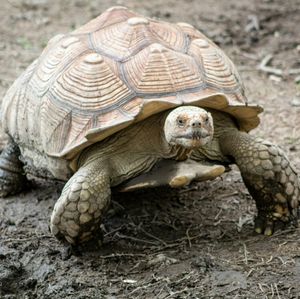
Sulcata Tortoise, African Spur-thigh Tortoise, Spurred Tortoise
Centrochelys sulcata
Adult Size: Males averaging around 180 lb and up to 3 feet shell length with some males exceeding 200 pounds. Females on average considerably smaller maxing out at around 2 feet long.
Lifespan: 50-75+ years
The world’s third largest tortoise and the only mainland giant tortoise, Sulcata tortoises are native to semiarid grasslands, savannas, and thorn shrublands in Central Africa. These large burrowing tortoises prefer habitats with shrubs and high grasses. Their burrows can reach depths of up to 100 feet deep in the wild as they dig to find high moisture levels in which to escape during the heat of the summer for estivation.
While wild populations remain endangered, in captivity this prolific species faces the opposite problem. Large numbers of sulcata tortoises reside in shelters and sanctuaries throughout the country. Well-meaning owners often find themselves starting with a small hatchling that rapidly grows into a large, destructive adult they were not fully prepared for. This coupled with females producing large clutches that easily incubate naturally in the ground has led to a homeless tortoise crisis for this species. Those interested in this species must be prepared for their eventual adult size and should consider adoption of older animals instead of a hatchling. Breeders should consider the overpopulation issue and venture into producing more of this species with caution.
Hatchlings can temporarily be housed indoors in a tortoise table or Waterland tub, but prepare to house this tortoise outdoors as it grows. This tortoise requires a large, secure enclosure or yard. They can easily dig under fences and other structures. They are often quite destructive of landscaping and patio furnishings as well. Tortoises under 60 lbs need protection from predators, while large animals are nearly immune to predators.
Males are territorial and will fight violently with one another ramming and biting, so males should be housed separately. Even an overly zealous male may turn his aggression towards females, other pets, or even the humans living near him.
Sulcata tortoises do not hibernate and need to be provided with a heated shelter. For information on setting up a heated tortoise shelter, click here.
Indoors: Cypress Mulch, Chipped Coconut Husk
Outdoors: Topsoil, grass
Avoid: gravel, sand, cedar chips, pine shavings, aspen shavings
The preferred optimal temperature zone of this species is between 85-95 degrees. Outdoors they will retreat into cooler burrows in hotter weather. Indoors, establish a temperature gradient within the enclosure with heat lamps and other overhead heating elements with a warm end of 85-90 degrees F and a cool end no cooler than 70 degrees F. Heat rocks should be avoided as they do not heat the enclosure adequately and can be a burn hazard for your pet.
Temperatures should always be monitored with a digital thermometer or infrared thermometer. Thermostats are also useful to ensure temperatures remain fairly constant within the enclosure.
Recent studies suggest that constant heat supplementation contributes to pyramiding, a common shell deformity seen in this species. It is recommended that temperatures be allowed to drop cooler at night into the 70s for this reason.
Tortoises require UVB lighting to process calcium properly. UVB lighting should be provided using either fluorescent (tube or "spiral" bulbs) or mercury vapor bulbs designed specifically for use in reptiles. When selecting fluorescent bulbs the high-output 10.0 bulbs are recommended as tortoises require fairly high levels of UVB exposure. It should be noted that these bulbs will stop providing UVB long before they stop producing visible light so they will need to be changed regularly, usually every 6 to 12 months depending on the manufacturer's recommendations.
This species is a grazing tortoise, so the majority of their diet should consist of grasses and hays. In reality the best diet for a sulcata tortoise is to provide it with a healthy lawn on which to munch.
Feed Daily/Staple – Grasses, Hays, Shrubs, Weeds, Forbs, and Alfalfa (plants).
Feed Occasionally - Cactus pad/leaf (prickly pear), Cactus pear (prickly pear), Collard greens, Dandelion greens, Endive, Escarole, Mustard Greens, Squash (acorn, butternut, hubbard, scallop, spaghetti, summer), Turnip greens, Alfalfa sprouts, Apples, Apricots (fresh), Beans (garbanzo, green, kidney, lima, pinto), Bell peppers, Blackberries, Blueberries, Cabbage (red), Cantaloupe, Carrots (raw), Celery, Cherries (no pit), Cilantro, Clover, Cranberries (fresh), Cucumbers, Grape leaves, Grapefruit, Grapes, Honeydew melons, Nectarines, Oranges, Pea sprouts, Peaches, Pears, Pineapple, Prunes, Pumpkin (raw), Radish, Raisins, Kelp, Strawberries, Watermelon, Wheatgrass (pet grass), and Yams (raw).
Feed Rarely - Banana, Soybeans, Beet greens, Beets, Broccoli, Cauliflower, Corn, Egg (whole, hard-boiled), Kiwi, Lettuce (red leaf, romaine), Olives (canned, pitted), Parsley, Peas, Pomegranate, Potato, Raspberries, Rice, Rutabaga, Brussels sprouts, Starfruit, Swiss chard, Tomato.
Do NOT feed - Meat, Insects, Bran, Bread, Cheerios, Chives, Eggplant, Garlic, Lettuce (loose leaf, iceberg), Mushrooms, Onion, Pasta, Spinach*, or Yogurt
Juvenile tortoises (less than 2 years of age) also should be offered Mazuri LS pellets softened in water every 2-3 days to give them a small amount of protein and extra carbohydrates to help them build muscles and body condition.
Soak tortoises in shallow warm water for 15 minutes 2-3 times weekly to encourage drinking, urination, and defecation.
Indoor tortoises should be supplemented with a calcium carbonate powder mixed into their food twice weekly.
Indoors: Provide multiple hide boxes throughout the enclosure. One should be set up as a “humid hide” with moist sphagnum moss or similar substrates to provide a humid microenvironment for shell health.
Outdoors: Provide an artificial burrow and edible bushes and shrubs
Droppings should be removed as soon as possible. Disinfect the enclosure regularly using either Rescue disinfectant or a mixture of 1 tablespoon bleach to 1 cup of water, make sure to rinse thoroughly after. Bowls should be disinfected at least weekly. Disinfect the entire habitat every 1 to 2 months again rinsing it thoroughly with water and allowing it to air out for at least an hour before returning your pet to the enclosure.
Copyright © All Rights Reserved
